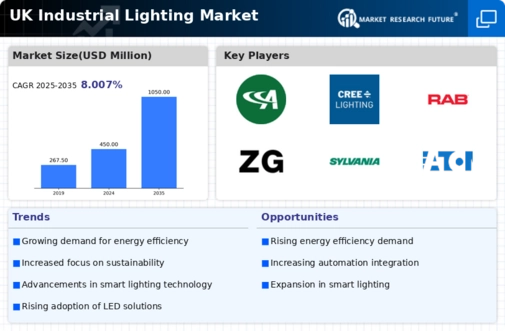Increased Focus on Workplace Safety
Workplace safety remains a paramount concern for industries across the UK, influencing the industrial lighting market. Adequate lighting is essential for ensuring safe working conditions, particularly in manufacturing and warehousing environments. Poor lighting can lead to accidents and injuries, prompting businesses to invest in high-quality lighting solutions. The Health and Safety Executive (HSE) in the UK emphasizes the importance of proper lighting in reducing workplace hazards. As a result, companies are increasingly prioritizing lighting upgrades to comply with safety regulations and enhance employee well-being. This focus on safety is likely to drive a substantial portion of the industrial lighting market, with estimates suggesting that safety-compliant lighting solutions could represent approximately 25% of the market by 2025.
Growing Demand for Energy Efficiency
The industrial lighting market in the UK is experiencing a notable shift towards energy-efficient solutions. This trend is driven by increasing operational costs and the need for businesses to reduce their carbon footprint. As energy prices continue to rise, companies are seeking lighting solutions that not only lower energy consumption but also enhance productivity. The UK government has set ambitious targets for reducing greenhouse gas emissions, which further propels the demand for energy-efficient lighting systems. In 2025, it is estimated that energy-efficient lighting could account for over 60% of the total industrial lighting market, reflecting a significant transition towards sustainable practices. This growing demand for energy efficiency is likely to reshape the competitive landscape of the industrial lighting market, encouraging innovation and investment in advanced technologies.
Expansion of the Manufacturing Sector
The expansion of the manufacturing sector in the UK is a key driver of growth in the industrial lighting market. As manufacturing activities increase, the demand for efficient and effective lighting solutions rises correspondingly. The UK government has been actively promoting manufacturing through various initiatives, which has led to a resurgence in this sector. Enhanced lighting solutions are essential for improving productivity and operational efficiency in manufacturing facilities. It is anticipated that by 2025, the manufacturing sector will contribute significantly to the industrial lighting market, potentially accounting for over 50% of total market revenue. This growth is indicative of the critical role that lighting plays in supporting the operational needs of the manufacturing industry.
Sustainability Initiatives by Corporations
The industrial lighting market is witnessing a surge in sustainability initiatives undertaken by corporations in the UK. Many companies are committing to reducing their environmental impact, which includes upgrading to sustainable lighting solutions. This trend is not only driven by regulatory pressures but also by consumer demand for environmentally responsible practices. Corporations are increasingly recognizing that sustainable lighting can lead to long-term cost savings and improved brand reputation. As a result, investments in eco-friendly lighting technologies are on the rise. By 2025, it is projected that the share of sustainable lighting solutions in the industrial lighting market could reach 40%, reflecting a broader commitment to sustainability across various sectors.
Technological Advancements in Lighting Solutions
Technological innovation plays a crucial role in the evolution of the industrial lighting market. The introduction of advanced lighting technologies, such as smart sensors and automated control systems, is transforming how businesses approach lighting. These innovations not only improve energy efficiency but also enhance operational flexibility. For instance, the integration of IoT (Internet of Things) in lighting systems allows for real-time monitoring and management, which can lead to energy savings of up to 30%. As industries in the UK increasingly adopt these technologies, the industrial lighting market is expected to grow significantly. By 2025, the market could see a compound annual growth rate (CAGR) of around 8%, driven by the demand for smarter, more efficient lighting solutions that align with modern operational needs.























Leave a Comment